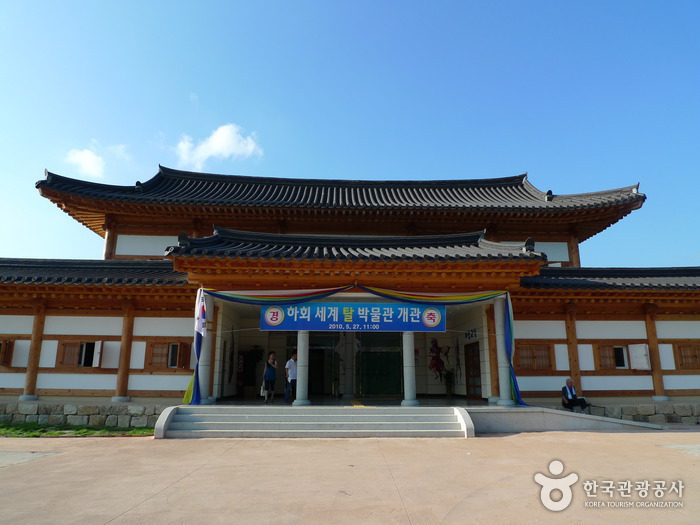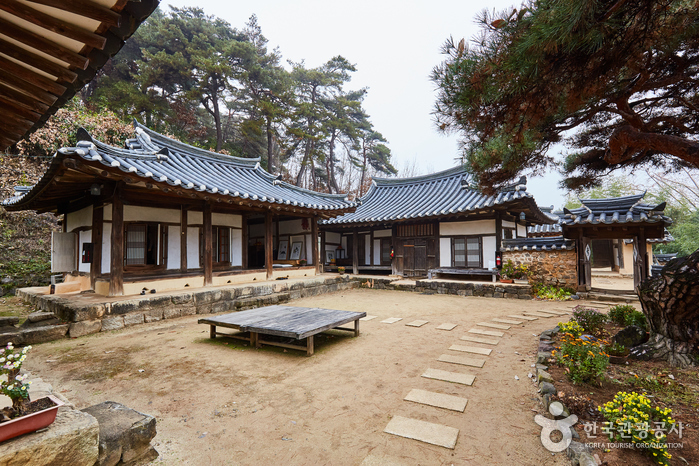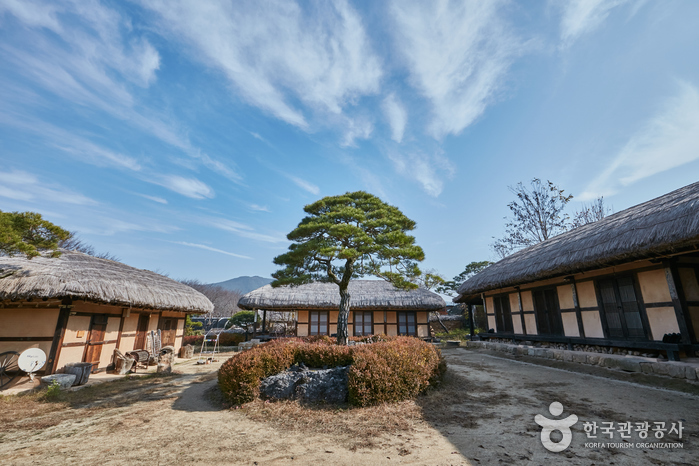Academia Neoconfuciana Byeongsan Seowon (병산서원) [Patrimonio Cultural de la Humanidad de la Unesco]
15.4Km 2024-05-07
Byeongsan-gil 386, Pungcheon-myeon, Andong-si, Gyeongsangbuk-do
Byeongsan Seowon es una academia neoconfuciana que fue fundada para honrar la memoria de Seong-nyong Yu (1542-1607), un personaje respetado por su carácter y por sus escrituras. En 1863, este tipo de escuelas tenían muchas libertades bajo las leyes Joseon, incluso no debían pagar impuestos y otros gastos. El río Nakdonggang está situado justo enfrente de la academia. Si se cruza, se llega hasta el monte Byeongsan.
Aldea Hahoe de Andong (안동 하회마을) [Patrimonio Cultural de la Humanidad de la Unesco]
16.1Km 2024-11-19
Jeonseo-ro 186, Pungcheon-myeon, Andong-si, Gyeongsangbuk-do.
La aldea Hahoe de Andong ha preservado la arquitectura de las casas y la estructura de una aldea tradicional de la dinastía Joseon. Asimismo, hay que destacar que la aldea no fue creada en forma artificial; hay gente que realmente vive allí.
El río Nakdonggang rodea tres de los cuatro flancos de la aldea Hahoe (Material Tradicional de Importancia). La aldea lleva el nombre de Hahoe porque el río forma un remolino alrededor de la misma y también se la conoce con el nombre de Aldea del Río Circular. Al lado de la aldea crecen numerosos pinos y se extiende un llano de suave arena, y frente a este se despliegan bellísimos acantilados. Esta aldea pasó al conocimiento público por una escuela confuciana de la dinastía Joseon (1392-1910), de los maestros Gyeomam (seudónimo de Ryu Un-ryong, 1539-1601) y Seoae (seudónimo de Ryu Seong-ryong, 1542-1607), que realizaron grandes hazañas durante la Guerra de Imjin en 1592.
Gracias a que la aldea está rodeada de las montañas y el río, nunca ha sufrido una invasión. Esta es la razón porque sus casas siguen conservando sus estructuras originales. En la aldea residen 180 familias y son conocidas como el Grupo de la Aldea, pertenecientes a la familia Pungsan Ryu. Dentro de ella, hay casas que fueron designadas Tesoros Nacionales, como por ejemplo Yangjindang y Chunghyodang. Asimismo, hay material importante de tradiciones, como la Casa Hahoe Bukchon, la Casa Hahoe Namchon y Hahoe Juilje. Las casas así designadas calificadas ayudan a preservar el estado original de la aldea de la familia Ryu, especialmente sobre los pilares de referencia de Ryu Un-ryong y Ryu Seong-ryong.
La aldea Hahoe es también famosa por el exorcismo Byeolsingut, la danza de máscara y la Máscara Hahoetal. La Máscara Hahoe-Byeongsantal es la más antigua de Corea y se la usa en la Danza de Máscaras Byeolsingut. La Aldea Hahoe se volvió más popular desde la visita de la Reina Isabel II del Reino Unido en 1999, y durante este tiempo se ejecutaron muchos eventos de Danza de Máscaras.
El Festival Internacional de Danza de Máscaras de Andong tiene lugar entre fin de setiembre y principios de octubre, a lo largo de 10 días aproximadamente, dentro de la Aldea Hahoe y otras áreas designadas.
Museo de Máscaras del Mundo de Hahoe (하회세계탈박물관)
16.3Km 2024-05-14
Jeonseo-ro 206, Pungcheon-myeon, Andong-si, Gyeongsangbuk-do.
Acantilado Buyongdae (부용대)
17.2Km 2024-11-18
Gwangdeoksolbat-gil 72, Pungcheon-myeon, Andong-si, Gyeongsangbuk-do
Buyongdae es un acantilado de unos 64 m de altura situado al final de la cordillera Taebaeksan. Desde la cima, se puede obtener una vista panorámica de la Aldea Hahoe de Andong. Su nombre fue tomado de una historia antigua de China y significa "loto". Cerca de este lugar se encuentran los templos Ogyeonjeongsa y Gyeomamjeongsa y la Academia Neoconfuciana Hwacheon Seowon.
Okyeon pavilion / 옥연정사
17.3Km 2025-08-12
86, Gwangdeoksolbat-gil Pungcheon-myeon, Andong-si, Gyeongsangbuk-do
+82-54-854-2202 / +82-10-4520-3640
Ogyeonjeongsa House was established by Ryu Seong-yong (pen-name: Seoae, 1542-1607), a minister of Joseon, with the help of Buddhist monk Tanhong, as a place to study and educate his students. After building Wonjijeongsa House, Ryu wanted to build another house at the foot of Buyongdae Cliff amid a tranquil environment away from the village, but due to his financial situation he was unable to complete the building by himself. Then, the monk Tanhong helped him build Ogyeonjeongsa House, which took ten years (1576 to 1586) to complete, when Ryu was 45 years old. Later, Ryu Seong-yong was able to share warmth with his brother (Gyeomam), who lived in nearby Gyeomamjeongsa House. Ryu later lost his house in Hahoe in the great flood of the Nakdonggang River in 1605, and retired to Ogyeongjeongsa House where he wrote Jingbirok (The Book of Correction, National Treasure 132), a memoir of the Imjin War (Japanese Invasion of Korea in 1592). The house’s guestrooms include Sesimjae (meaning ‘having a mind to this place to achieve at least one in ten thousand things,’ inspired by the I Ching or The Book of Changes), which was used by Ryu as a schoolhouse and has two small rooms between the maru gamheonrok (wooden floor, meaning ‘looking up at the sky and down at the blue water,’ inspired by Wang Xizhi’s poetic diction); Wonlakjae (meaning ‘waiting for a friend’s visit,’ inspired by the Analects of Confucius), in which Ryu himself resided and wrote Jingbirok; and the maru aeoheon (meaning ‘I also love my hut,’ taken from a poem by Chinese poet Tao Yuanming), which measures two kan (a unit of measurement referring to the distance between two columns).
RakKoJae Andong(Hahoe) / 락고재 안동(하회)
17.6Km 2025-08-12
51, Hahoegangbyeon-gil, Pungcheon-myeon, Andong-si, Gyeongsangbuk-do
+82-54-857-3410
Rakkojae, meaning “a place where one can enjoy ancient traditions and rest one’s soul”, is located near the beautiful ferry on the Nakdonggang River in Hahoe, Andong. After passing by a pine tree decorated with traditional Korean lanterns and entering the cozy courtyard, visitors will find four well-maintained houses with thatched-roofs made with local rice straw. As Rakkojae is some way from the Hahoe Village, and is adjacent to the Nakdonggang River, guests can enjoy walking along the ferry and the walkway while appreciating the beautiful scenery of the river and Buyongdae Cliff with its serene atmosphere. Rakkojae has three guest accommodations – the anchae at the front, the sarangchae and the byeolchae on the sides, and the munganchae. While the anchae has two rooms, a kitchen and a daecheong (main floored room), both the sarangchae and the byeolchae consist of a daecheong and one room. The maximum number of guests per room is ten so that guests can enjoy their stay with ease. Each room is decorated with hanji (traditional Korean paper handmade from mulberry trees) and features a simple built-in closet, ceiling-type air conditioning, and a modern bathroom with a toilet and a bathtub made of Hinoki cypress. In particular, the munganchae has a red clay jjimjilbang (Korean dry sauna) supplied with mugwort that is popular among both domestic and foreign guests. Guests often enjoy relaxing at Rakkojae by appreciating the sunshine and breeze while lying on the daecheong floor, walking barefoot on the earthen ground, and drinking makgeolli (unrefined rice wine)among other activities. The owners of Rakkojae hope that it will be a place where guests can heal their tired body and mind and experience the true atmosphere of Korea. The Pine Wood of Mansongjeong Pavilion (Natural Monument No. 473) situated next to Rakkojae is also a good place for a stroll. Furthermore, the hotel serves a hearty breakfast consisting of heotjesatbap (Andong-style bibimbap with soy sauce) and salted grilled mackerel.
Yangjindang (하회 양진당)
17.7Km 2025-07-01
68, Hahoejongga-gil, Andong-si, Gyeongsangbuk-do
“Andonog Hahoe Yangjindang,” located in the Hahoe Folk Village, is Treasure No 306 and the residence of a family with the surname Pungsan Ryu. A tablet read Ipam Antique House, named after Ipam Ryu Jung Yeong (1515 - 1573), is hung on the entrance. Yangjindang is named after the nickname of Ryu Yeong (1687 - 1761), the sixth generation of Gyeongam Ryu Un Ryong, son of Ipam. The name means “nourishing well one's own nature.” The Hanok stands over the entrance, with a well-polished floor that is grand yet friendly. One of the characteristics of the house is that it includes Sarangcha or detached building, which reflects the architecture from the Goryeo period, and Anchae or main building in the architecture style from the Joseon period.
It is expected that such co-existence was made possible because of the repairs done after Imjin War. How fortiunate that the antique house has been preserved until now! The well-tended garden shows the commitment of the descendants to maintaining the space. Rooms are rather simple compared to the grand exterior of the house. Traditional mother-of-pearl furniture, tableware in the cupboard, randomly ceramics placed draw attention. The house resembles a small folk museum. Why not enjoy some traditional folk games during your stay? There is a variety of play tools such as yut, tuho, jegi, tops, and kites. Experience programs such as gayangju brewing, rice cake and traditional dessert making, and flower tea are conducted by the first daughter-in-law of the house, depending on the season.
Festival de la Cultura de los Eruditos Coreanos de Yeongju (영주 한국선비문화축제)
18.1Km 2025-04-23
Sobaek-ro 2796, Sunheung-myeon, Yeongju-si, Gyeongsangbuk-do.
054-630-8708 / 054-639-6612
El Festival de la Cultura de los Eruditos Coreanos de Yeongju es un evento local celebrado en la Aldea Seonbichon y el Centro Cultural Seonbi de Corea. Durante la festividad, se realizan distintas actividades de entretenimiento y eventos secundarios como desfile callejero, espectáculo de bibimbap (plato tradicional coreano con arroz y vegetales), corte de la cinta para la inauguración, elaboración de tótem o concurso de cocina, atrayendo de esta manera a muchos visitantes.
Academia Neoconfuciana Dosan Seowon (도산서원) [Patrimonio Cultural de la Humanidad de la Unesco]
18.2Km 2024-05-17
Dosanseowon-gil 154, Dosan-myeon, Andong-si, Gyeongsangbuk-do.
La Academia Neoconfuciana Dosan Seowon fue fundada en 1574 (séptimo año del rey Seonjo), por discípulos confucianos y otros que apreciaban las memorias del ministro Lee Hwang. Era una academia donde Lee Hwang, cuyo seudónimo era Toegye, instruyó a sus estudiantes y se concentró en sus estudios académicos. En 1574, ya durante la dinastía Joseon (1392-1910), los eruditos confucianos y otros literatos establecieron un mausoleo denominado Sangdeoksa, que en 1969 fue designado Tesoro Nacional. Después de ubicar el mortuorio y ejecutar los ritos sacrificiales, finalizaron con la construcción de la academia mediante la edificación de Jeongyodang (Tesoro Nacional) y las alas Este y Oeste (donde los estudiantes podían estudiar). Cuando se terminó de edificar la academia, el rey Seonjo hizo entrega de la tabla con el nombre de la institución. Cuando se entra por la puerta principal, se podrá ver a la academia Dosan Seowon sobre la derecha. La estructura de esta construcción es simple con pilares cuadrados y vigas sencillas insertadas perpendiculares a los pilares. Entrando por la puerta Jindomun, hallará la Gwangmyeongsil donde se guardaban los libros. También verá el Jeongyodang, edificio principal, y las alas Este y Oeste. Detrás de Jeongyodang se encuentra el Mausoleo Sangdeoksa y el Jangpangak, un árbol para imprimir las "12 Canciones de Dosan". El Okjingak que fue reconstruido en 1970, funciona actualmente como expositor de las reliquias del maestro Toegye, tales como sus objetos, muebles y libros favoritos, entre otras.
Nosongjeong Head House (노송정종택(퇴계생가))
18.6Km 2025-06-17
46-5, Onhyejungma-gil, Andong-si, Gyeongsangbuk-do

![Aldea Hahoe de Andong (안동 하회마을) [Patrimonio Cultural de la Humanidad de la Unesco]](http://tong.visitkorea.or.kr/cms/resource/43/2654743_image2_1.jpg)






 Español
Español
 한국어
한국어 English
English 日本語
日本語 中文(简体)
中文(简体) Deutsch
Deutsch Français
Français Русский
Русский